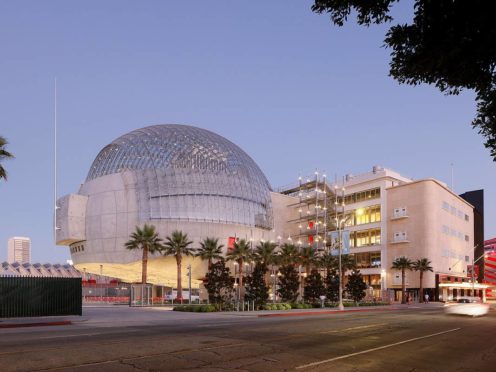Tom Hanks was on hand to unveil the long-delayed Academy Museum of Motion Pictures, the new venue dedicated to the history of film and the Oscars.
The 30,000-square-foot venue – built at a reported cost of 482 million dollars (£352 million) – is based in Los Angeles at the eye-catching Saban Building, instantly recognisable for its Art Deco golden rotunda.
It also includes a newly built concrete and glass dome, which protrudes above the mid-city skyline and has been referred to as “the Death Star” – though not by its creator.

Among the “legendary” film props on display at the museum is a 25-foot-long fibreglass model of Bruce the shark from Steven Spielberg’s Jaws – the fourth and final cast from the original mould.
The ruby slippers worn by Judy Garland in The Wizard Of Oz can be seen by visitors, as can a C-3PO costume and an R2-D2 model from Star Wars.
Museum bosses have promised the venue will not shy away from the controversial aspects of Hollywood history.
A video shown at a curtain-raising event on Tuesday promised “no-one will be unseen” while Bill Kramer, director and president of the museum, said it will be “diverse, inclusive and accessible”.
Hanks was a key member of the fundraising committee for the museum, alongside actress Annette Bening and Disney chief Bob Iger.

Discussing why he worked for years to make the idea a reality, the Oscar-winner, 65, said: “It’s mostly because it matters for Los Angeles to have this film museum. We all know films are made everywhere in the world and they are wonderful films and there are other cities with film museums.
“But with all due respect, a place like Los Angeles, created by the Motion Picture Academy, this museum has really got to be the Parthenon of such places.
“Do we need a movie museum? Yes. Because we need to celebrate everything that this town has brought to the world and everything (the) art form has brought to the world in order to bring people together.”
Hanks said whether viewing films in a theatre or streaming at home, “movies continue to be the magical art that speaks to everybody everywhere”.
He added: “And does that art deserve to be honoured and explored and enjoyed in a museum? I hope the question answers itself.”
Hanks said the museum “exceeds our dreams by about 10-fold”, hailing the “extraordinary building” as an “inclusive space”.
He recalled watching some of his favourite films in cinemas while discussing lanterns used to create moving images centuries ago.
Hanks described the Academy Museum as, “the world’s largest magic lantern that will transport us to amazing places, simply by getting together with a couple of strangers and walking into a dark room and sharing the experience”.
Renzo Piano, the acclaimed architect responsible for the Academy Museum, also appeared at the press event and jokingly pleaded with the audience not to use a Star Wars-inspired name for his creation.
“Do not call this the Death Star,” the 84-year-old Italian said, referencing the Galactic Empire’s spherical superweapon.
“Call it a flying vessel, ready to land or ready to take off.”
Piano also suggested the dome could be called the “soap bubble”.
Exhibitions at the museum include Stories Of Cinema, said to offer “celebratory, critical and personal perspectives” on film-making past and present.
Hayao Miyazaki will explore the Japanese filmmaker’s body of work, including that of animation studio Studio Ghibli, which he co-founded.
Backdrop: An Invisible Art includes a painting of Mount Rushmore famously used in Alfred Hitchcock’s 1959 classic North By Northwest.
And The Oscars Experience features an immersive simulation letting visitors see what it is like stepping on stage at the Dolby Theatre to accept an Academy Award.
The Academy Museum of Motion Pictures will open its doors to the public on September 30.
